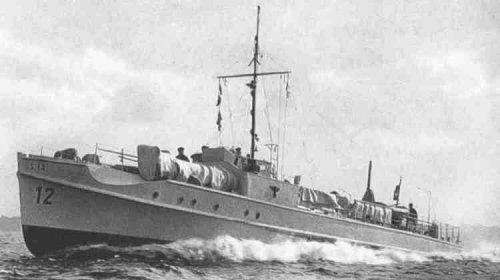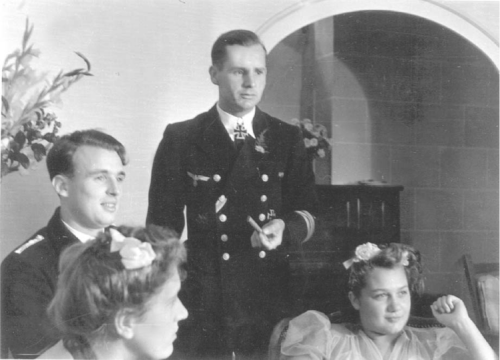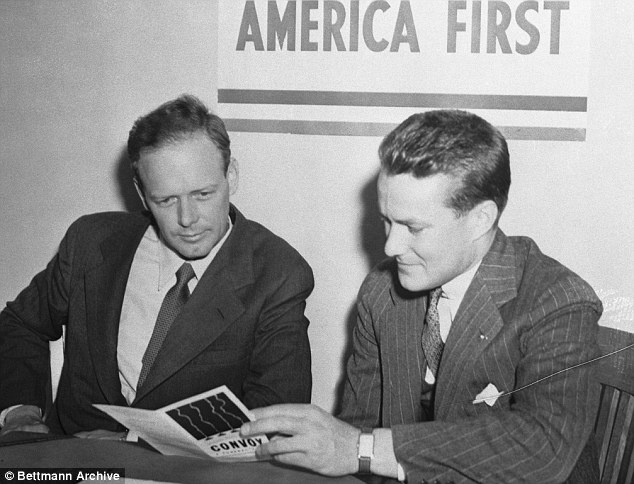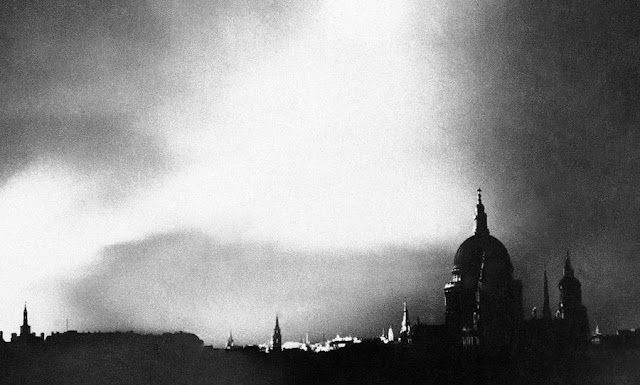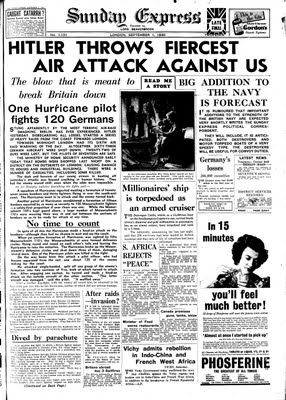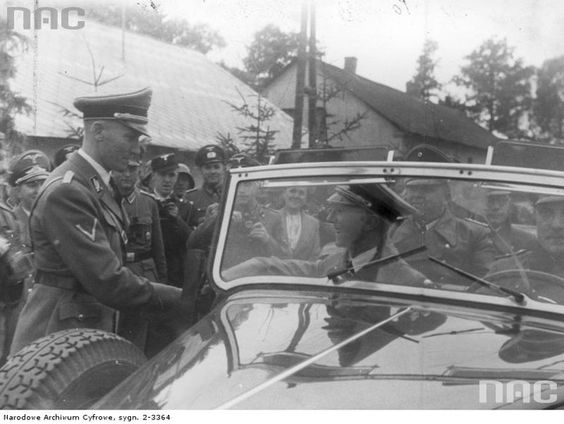Saturday 14 September 1940
German Military: Adolf Hitler meets with his top cronies from the three services on 14 September 1940. After much blather, he postpones the date of Operation Sealion again. This is typical, as Hitler tends to postpone invasion decisions multiple times until he feels the time is just right. This has worked - so far.
Hitler is enthusiastic about Operation Sealion. However, he decides that the Luftwaffe just needs another four or five days of good weather to finish off the RAF. Thus, he gives Reichsmarschall Hermann Goering carte blanche to act as necessary to eliminate the RAF as a bar to the operation. However, time also is limited because the tides will be best only on the 27th, and the invasion forces need 10 days to prepare. Unless Hitler is willing to risk beginning the operation deep in autumn, September 17, 1940, will be the drop-dead date for Operation Sealion.
There are two main problems:
The only time the Luftwaffe seemed to be making progress was when it was attacking RAF airfields and infrastructure exclusively in early September. Hitler and Goering, however, ruined the momentum with the switch to bombing London on 7 September. Now that Hitler has given Goering freedom of action, he may have one last chance to vanquish the RAF, but only by learning from experience and returning to the earlier tactics.
Looking at this incident in retrospect, it is easy to be cynical. Hitler appears to be putting on an act for his own hidden purposes. While he in effect gives the service chiefs a pep talk, in fact, he is not enthusiastic about the invasion at all (as we know from subsequent events). It is impossible to read motivations based on the thin evidence and at this distance, but one can always make some guesses. Hitler may be "playing" Goering and the other commanders to get one last good effort from them before he shelves Sealion for good - at which point they will almost certainly slack off. However, he has a few more days before he has to decide anything.
Battle of Britain: The weather remains poor, with rain and clouds. However, there are openings in the clouds here and there that permit operations.
The morning sees only a few reconnaissance and weather flights, the norm since the change in strategy on 7 September. Finally, at about 15:30, the Luftwaffe mounts a major operation. About 150 Luftwaffe planes cross the coast near Deal, heading toward London. Another 100 aircraft follow and also attack the center of London. At this point, the center of the capital is ringed by artillery in what is known as the Inner Artillery Zone, and the anti-aircraft fire is intense. However, the RAF remains the main defensive force.
Fierce air battles develop over the Thames Estuary. The bomber escort is especially thick, and the Bf 109s have a good day. RAF No. 73 Squadron, on the other hand, loses three aircraft and has four others badly damaged. The Luftwaffe pilots put in 25 claims, but actual RAF losses are 12 fighters lost and another 9 damaged.
The damage to the city is concentrated in Battersea, Lambeth, and Camberwell. Burst water main in Lambeth stops traffic, and other underground infrastructure takes a beating. There is minor damage to power stations and the Southern Railway Bridge.
At 18:10, the Luftwaffe sends another large force across Dover. This catches the RAF fighters on the ground, but they get up quickly and frighten off many of the bombers. Only a few bombers reach London and they don't cause much damage.
After dark, the Luftwaffe sends over a few raids which are not very successful. They hit various widely dispersed targets in the North Midlands, Essex, and throughout southern England. Kingston, Wimbledon, Brighton, Eastbourne, Ipswich and in Northwestern England all take damage, but usually only randomly dropped bombs that miss anything vital.
Overall, despite the weather, it is a very good day for the Luftwaffe. Losses are even at 14 apiece. The pilots return to base full of enthusiasm about the apparent weakness of Fighter Command.
The Experten of elite fighter formation JG 26 have a great day. Adolf Galland of JG26 gets his 31st victory, a Hurricane over London. Oblt. Joachim Müncheberg of 7./JG 26 gets his 20th victory - entitling him to the Ritterkreuz. Hptm. Rolf Pingel of Stab 1,/JG 26 gets his 15th victory and also is awarded the Ritterkreuz, perhaps in sympathy with all the successes elsewhere in the squadron.
Other top pilots also have a good day. Kommodore of JG 51 Major Werner Mölders gets his 37th victory, a Spitfire over London. Walter Oesau of Stab III./JG 51, meanwhile, shoots down two Spitfires to reach 26 victories.
Douglas Bader of Group 12 is awarded the D.S.O. RAF No. 302 "Polish" Squadron moves to Duxford to join Bader's "Big Wing."
Luftwaffe pilot Oberstlt. Walter Grabmann receives the Knight's Cross of the Iron Cross.
One obscure incident illustrates what is going on with the RAF. A Hurricane of No. 43 Squadron crashes on landing because the pilot, C.K. Gray, is flying with injuries to his arm sustained on 26 August. The RAF remains strained, and cold figures on force tables cannot capture the wear and tear on the front-line men.
RAF Bomber Command attacks the German coastal guns at Cap Gris Nez, without success.
European Air Operations: RAF Bomber Command continues its attacks on the northwest European ports harboring invasion barges and airfields. In addition, it bombs various points along the supply chain to those ports, including Osnabruck, Mannheim, Aachen, Hamm, Krefeld, and Brussels. The major British theme of attacking railway installations continues, with stations attacked at Rheine, Ahaus, Sundern, Husten, and West-Hofen. It launches a particularly heavy attack on Antwerp, where German re-supply efforts would originate.
Battle of the Atlantic: Italian submarine Emo (Captain Carlo Liannazza), which has passed through the Straits of Gibraltar en route to the new BETASOM base at Bordeaux, is north of the Azores when it torpedoes and sinks 5199-ton British cargo ship (former tanker) Saint Agnes. Saint Agnes is part of Convoy SL 46. Everybody aboard survives.
British submarine HMS Tuna torpedoes and sinks 1281 ton merchant catapult seaplane tender Ostmark (two seaplanes) southwest of St. Nazaire. It is torpedoed at 05:42 and sinks at 08:10. There is one death.
Vichy French ocean liner Flandre hits a mine and sinks south of La Rochelle, Charente-Maritime, in the Bay of Biscay. It splits in two and sinks quickly.
Kriegsmarine trawler NM 11 sinks from fire at its anchorage at Kristiansund, Møre og Romsdal, Norway. There are four deaths.
Two of the three Vichy French cruisers of Force Y make port at Dakar. The third cruiser, Gloire, experiences engine issues and falls behind. It is intercepted by British cruiser Australia which orders it return to Casablanca. The British fleet chasing the cruisers does not know where they are, but it gives up the pursuit anyway and heads to Freetown, West Africa.
At Freetown, the British fleet, led by battleships HMS Barham and Resolution and including French sloops Commandant Domine and Commandant Duboc, prepares for Operation Menace, the attack on Dakar. Offshore, aircraft carrier HMS Ark Royal and other ships continue to patrol off Dakar, not realizing that the Vichy French cruisers are already there.
U-96 (Kapitänleutnant Heinrich Lehmann-Willenbrock) is commissioned.
British corvette HMS Honeysuckle (K 27, Lt. George W. Gregorie) is commissioned.
Battle of the Mediterranean: The Italian units in Halfaya Pass descend down to meet the Italians advancing along the coast. The British (11th Hussar squadron, the 2nd Rifle Brigade and cruiser tanks of the 1st Royal Tank Regiment (1st RTR)) delay the Italians as much as possible. The Italians on the coast make progress, pushing the British back to Buq Buq, where the British get reinforcements. The British establish a major fallback position at the railhead of Mersa Matruh, which is a major destination for both sides throughout World War II (during fluid battles, a standing joke amongst the British is that the latest "Mersa Matruh stakes" is on). Halfaya Pass, too, we will be reading more about.
At Malta, there is an air raid alert around 2030. However, the bomber over Grand Harbour drops its bombs in the water and fleets, while scattered bombs drop in the north. Meanwhile, the army has been installing beach obstacles to deter invasion. They are concrete pyramid blocks set at the one-fathom mark in two staggered rows. However, there now is a shortage of concrete, and the weather is making installation difficult.
Japanese/Vichy French Relations: With the French stalling negotiations in protest at Japanese incursions into French Indochina, the Japanese decide to take advantage of Vichy French weakness. The Imperial General Headquarters issues orders for troops to move into French Indochina beginning on 22 September.
War Crimes: In Northern Transylvania, the Hungarians have completed their occupation of the territory ceded by Romania. At the village of Ip, Sălaj, Hungarian troops kill 55 civilians in the forest at Felsőkaznacs and Szilágcseres (present-day Cosniciu de Sus and Cerișa). The reason given is reprisals for guerrilla attacks on the occupying troops. Reports indicate that, in addition to the specific instances such as this one at Ip, the Hungarian soldiers simply march through towns killing people indiscriminately - and they do indeed find some guerillas, though only a fraction of the people killed. The number of people murdered will never be known, but it is assumed to be in the mid-hundreds. While there are killings throughout the region, this is generically known as the Ip Massacre.
This is one of a string of incidents in the region that inflame tensions between the Romanian inhabitants and the occupying force. Reports suggest that the troops are supported by local "vigilante groups" settling old scores with the Romanians who remain. This is a common theme throughout World War II, and not just in this region, with changes in control unleashing buried hatreds and resentments.
Romania: Ion Antonescu proclaims the new National Legionary State. This transforms the Iron Guard into the country's only official political party. Antonescu officially becomes Premier and Conducător, while Horia Sima becomes Deputy Premier and remains the leader of the Guard. Antonescu orders all imprisoned Iron Guard members released.
Free France: General de Gaulle receives more potential followers when the Ex-Servicemen’s General Assembly of Saint Pierre and Miquelon - two small islands off Newfoundland that contain French bases - pledge their support. However, the local Vichy authorities quickly crush the group. The islands remain outposts of Vichy France in the Western Hemisphere, along with bases in the Caribbean.
Australia: Troop Convoy US 5 departs for the Middle East.
US Military: General Jonathan Mayhew "Skinny" Wainwright IV, just promoted to Major General (temporary) departs New York City aboard US Army Transport Grant for the Philippines. He is taking up his new command there as the commander of the Philippine Detachment. He is or becomes one of General MacArthur's favorite Generals, and, while MacArthur at this time is in retirement, he is a Field Marshal in the Philippine Army and his opinion matters.
American Homefront: The draft is reinstated as President Roosevelt signs the Selective Service Act. For the first time in US history during peacetime, there is a draft - and it is very unpopular. All men between the ages of 21 and 35 must register with local draft boards pursuant to the Selective Training and Service Act of 1940, also known as the Burke-Wadsworth Act.
One of the little-remembered portions of the Selective Service Act of 1940 is that, for the first time, African Americans are permitted to join any branch of the military. This is a key and little-noted moment in civil rights history and has widespread and unexpected effects on society. It arguably begins the Civil Rights movement.
Future History: Larry Brown is born in Brooklyn, New York. He becomes a professional basketball player in the 1960s, then a very successful college and professional coach. Brown becomes famous/notorious for numerous job changes and a high career winning percentage. He resigned his most recent job as the coach at SMU in July 2016 after the NCAA imposed sanctions on the program for alleged violations, and it is unclear if he has retired.
September 1940
September 1, 1940: RAF's Horrible Weekend
September 2, 1940: German Troopship Sunk
September 3, 1940: Destroyers for Bases
September 4, 1940: Enter Antonescu
September 5, 1940: Stukas Over Malta
September 6, 1940: The Luftwaffe Peaks
September 7, 1940: The Blitz Begins
September 8, 1940: Codeword Cromwell
September 9, 1940: Italians Attack Egypt
September 10, 1940: Hitler Postpones Sealion
September 11, 1940: British Confusion at Gibraltar
September 12, 1940: Warsaw Ghetto Approved
September 13, 1940: Zeros Attack!
September 14, 1940: The Draft Is Back
September 15, 1940: Battle of Britain Day
September 16, 1940: italians Take Sidi Barrani
September 17, 1940: Sealion Kaputt
September 18, 1940: City of Benares Incident
September 19, 1940: Disperse the Barges
September 20, 1940: A Wolfpack Gathers
September 21, 1940: Wolfpack Strikes Convoy HX-72
September 22, 1940: Vietnam War Begins
September 23, 1940: Operation Menace Begins
September 24, 1940: Dakar Fights Back
September 25, 1940: Filton Raid
September 26, 1940: Axis Time
September 27, 1940: Graveney Marsh Battle
September 28, 1940: Radio Belgique Begins
September 29, 1940: Brocklesby Collision
September 30, 1940: Operation Lena
2020
Hitler is enthusiastic about Operation Sealion. However, he decides that the Luftwaffe just needs another four or five days of good weather to finish off the RAF. Thus, he gives Reichsmarschall Hermann Goering carte blanche to act as necessary to eliminate the RAF as a bar to the operation. However, time also is limited because the tides will be best only on the 27th, and the invasion forces need 10 days to prepare. Unless Hitler is willing to risk beginning the operation deep in autumn, September 17, 1940, will be the drop-dead date for Operation Sealion.
There are two main problems:
In a sense, the two problems are related. The weather has been miserable all summer long, and the Luftwaffe's equipment requires good weather to achieve its objectives. Obviously, nobody can blame the weather alone for the Luftwaffe's issues, but this shows that the state of the art of airpower - at least in the Luftwaffe, but everywhere else as well - is not advanced enough to achieve the German objectives with the tactics that the Luftwaffe has adopted.
- Winter is approaching;
- The Luftwaffe has not achieved air superiority.
The only time the Luftwaffe seemed to be making progress was when it was attacking RAF airfields and infrastructure exclusively in early September. Hitler and Goering, however, ruined the momentum with the switch to bombing London on 7 September. Now that Hitler has given Goering freedom of action, he may have one last chance to vanquish the RAF, but only by learning from experience and returning to the earlier tactics.
Looking at this incident in retrospect, it is easy to be cynical. Hitler appears to be putting on an act for his own hidden purposes. While he in effect gives the service chiefs a pep talk, in fact, he is not enthusiastic about the invasion at all (as we know from subsequent events). It is impossible to read motivations based on the thin evidence and at this distance, but one can always make some guesses. Hitler may be "playing" Goering and the other commanders to get one last good effort from them before he shelves Sealion for good - at which point they will almost certainly slack off. However, he has a few more days before he has to decide anything.
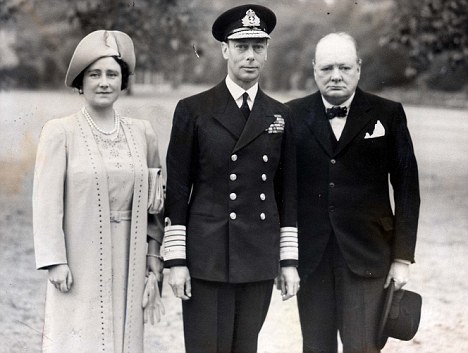 |
| King George VI and Queen Elizabeth (the Queen Mother), accompanied by Prime Minister Winston Churchill, tour the grounds of Buckingham Palace on September 14, 1940. |
The morning sees only a few reconnaissance and weather flights, the norm since the change in strategy on 7 September. Finally, at about 15:30, the Luftwaffe mounts a major operation. About 150 Luftwaffe planes cross the coast near Deal, heading toward London. Another 100 aircraft follow and also attack the center of London. At this point, the center of the capital is ringed by artillery in what is known as the Inner Artillery Zone, and the anti-aircraft fire is intense. However, the RAF remains the main defensive force.
Fierce air battles develop over the Thames Estuary. The bomber escort is especially thick, and the Bf 109s have a good day. RAF No. 73 Squadron, on the other hand, loses three aircraft and has four others badly damaged. The Luftwaffe pilots put in 25 claims, but actual RAF losses are 12 fighters lost and another 9 damaged.
The damage to the city is concentrated in Battersea, Lambeth, and Camberwell. Burst water main in Lambeth stops traffic, and other underground infrastructure takes a beating. There is minor damage to power stations and the Southern Railway Bridge.
At 18:10, the Luftwaffe sends another large force across Dover. This catches the RAF fighters on the ground, but they get up quickly and frighten off many of the bombers. Only a few bombers reach London and they don't cause much damage.
After dark, the Luftwaffe sends over a few raids which are not very successful. They hit various widely dispersed targets in the North Midlands, Essex, and throughout southern England. Kingston, Wimbledon, Brighton, Eastbourne, Ipswich and in Northwestern England all take damage, but usually only randomly dropped bombs that miss anything vital.
Overall, despite the weather, it is a very good day for the Luftwaffe. Losses are even at 14 apiece. The pilots return to base full of enthusiasm about the apparent weakness of Fighter Command.
The Experten of elite fighter formation JG 26 have a great day. Adolf Galland of JG26 gets his 31st victory, a Hurricane over London. Oblt. Joachim Müncheberg of 7./JG 26 gets his 20th victory - entitling him to the Ritterkreuz. Hptm. Rolf Pingel of Stab 1,/JG 26 gets his 15th victory and also is awarded the Ritterkreuz, perhaps in sympathy with all the successes elsewhere in the squadron.
Other top pilots also have a good day. Kommodore of JG 51 Major Werner Mölders gets his 37th victory, a Spitfire over London. Walter Oesau of Stab III./JG 51, meanwhile, shoots down two Spitfires to reach 26 victories.
Douglas Bader of Group 12 is awarded the D.S.O. RAF No. 302 "Polish" Squadron moves to Duxford to join Bader's "Big Wing."
Luftwaffe pilot Oberstlt. Walter Grabmann receives the Knight's Cross of the Iron Cross.
One obscure incident illustrates what is going on with the RAF. A Hurricane of No. 43 Squadron crashes on landing because the pilot, C.K. Gray, is flying with injuries to his arm sustained on 26 August. The RAF remains strained, and cold figures on force tables cannot capture the wear and tear on the front-line men.
RAF Bomber Command attacks the German coastal guns at Cap Gris Nez, without success.
 |
| Hurricane fighter planes take off from Gravesend after being refueled and rearmed during the cloudy afternoon to take on the next wave of bombers. 14 September 1940. |
Battle of the Atlantic: Italian submarine Emo (Captain Carlo Liannazza), which has passed through the Straits of Gibraltar en route to the new BETASOM base at Bordeaux, is north of the Azores when it torpedoes and sinks 5199-ton British cargo ship (former tanker) Saint Agnes. Saint Agnes is part of Convoy SL 46. Everybody aboard survives.
British submarine HMS Tuna torpedoes and sinks 1281 ton merchant catapult seaplane tender Ostmark (two seaplanes) southwest of St. Nazaire. It is torpedoed at 05:42 and sinks at 08:10. There is one death.
Vichy French ocean liner Flandre hits a mine and sinks south of La Rochelle, Charente-Maritime, in the Bay of Biscay. It splits in two and sinks quickly.
Kriegsmarine trawler NM 11 sinks from fire at its anchorage at Kristiansund, Møre og Romsdal, Norway. There are four deaths.
Two of the three Vichy French cruisers of Force Y make port at Dakar. The third cruiser, Gloire, experiences engine issues and falls behind. It is intercepted by British cruiser Australia which orders it return to Casablanca. The British fleet chasing the cruisers does not know where they are, but it gives up the pursuit anyway and heads to Freetown, West Africa.
At Freetown, the British fleet, led by battleships HMS Barham and Resolution and including French sloops Commandant Domine and Commandant Duboc, prepares for Operation Menace, the attack on Dakar. Offshore, aircraft carrier HMS Ark Royal and other ships continue to patrol off Dakar, not realizing that the Vichy French cruisers are already there.
U-96 (Kapitänleutnant Heinrich Lehmann-Willenbrock) is commissioned.
British corvette HMS Honeysuckle (K 27, Lt. George W. Gregorie) is commissioned.
 |
| Sgt George CC "Titch" Palliser reported to No 249 Squadron RAF at RAF North Weald on 14 September 1940. |
At Malta, there is an air raid alert around 2030. However, the bomber over Grand Harbour drops its bombs in the water and fleets, while scattered bombs drop in the north. Meanwhile, the army has been installing beach obstacles to deter invasion. They are concrete pyramid blocks set at the one-fathom mark in two staggered rows. However, there now is a shortage of concrete, and the weather is making installation difficult.
Japanese/Vichy French Relations: With the French stalling negotiations in protest at Japanese incursions into French Indochina, the Japanese decide to take advantage of Vichy French weakness. The Imperial General Headquarters issues orders for troops to move into French Indochina beginning on 22 September.
 |
| Hungarian troops in Zalău, near Ip, 9 September 1940. |
This is one of a string of incidents in the region that inflame tensions between the Romanian inhabitants and the occupying force. Reports suggest that the troops are supported by local "vigilante groups" settling old scores with the Romanians who remain. This is a common theme throughout World War II, and not just in this region, with changes in control unleashing buried hatreds and resentments.
 |
| Posted to No 249 Squadron RAF on 14 September 1940, P/O Albert G "Zulu" Lewis (left) of No 249 Squadron RAF enjoys a game of L'Attaque at RAF North Weald. |
Free France: General de Gaulle receives more potential followers when the Ex-Servicemen’s General Assembly of Saint Pierre and Miquelon - two small islands off Newfoundland that contain French bases - pledge their support. However, the local Vichy authorities quickly crush the group. The islands remain outposts of Vichy France in the Western Hemisphere, along with bases in the Caribbean.
Australia: Troop Convoy US 5 departs for the Middle East.
US Military: General Jonathan Mayhew "Skinny" Wainwright IV, just promoted to Major General (temporary) departs New York City aboard US Army Transport Grant for the Philippines. He is taking up his new command there as the commander of the Philippine Detachment. He is or becomes one of General MacArthur's favorite Generals, and, while MacArthur at this time is in retirement, he is a Field Marshal in the Philippine Army and his opinion matters.
American Homefront: The draft is reinstated as President Roosevelt signs the Selective Service Act. For the first time in US history during peacetime, there is a draft - and it is very unpopular. All men between the ages of 21 and 35 must register with local draft boards pursuant to the Selective Training and Service Act of 1940, also known as the Burke-Wadsworth Act.
One of the little-remembered portions of the Selective Service Act of 1940 is that, for the first time, African Americans are permitted to join any branch of the military. This is a key and little-noted moment in civil rights history and has widespread and unexpected effects on society. It arguably begins the Civil Rights movement.
Future History: Larry Brown is born in Brooklyn, New York. He becomes a professional basketball player in the 1960s, then a very successful college and professional coach. Brown becomes famous/notorious for numerous job changes and a high career winning percentage. He resigned his most recent job as the coach at SMU in July 2016 after the NCAA imposed sanctions on the program for alleged violations, and it is unclear if he has retired.
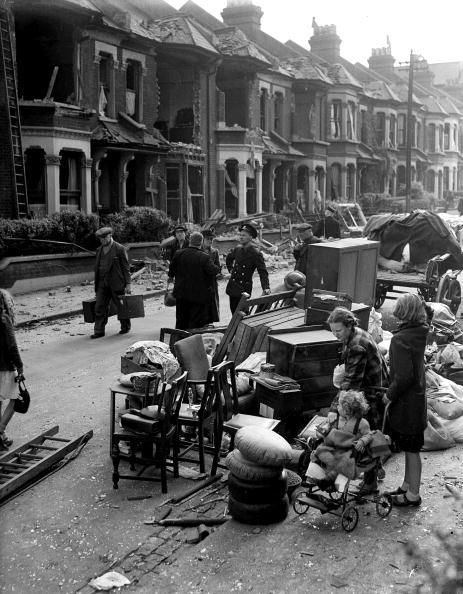 |
| On 14 September 1940, refugees with their salvaged furniture and belongings linger in front of their damaged homes in the London area (Photo by Popperfoto/Getty Images). |
September 1, 1940: RAF's Horrible Weekend
September 2, 1940: German Troopship Sunk
September 3, 1940: Destroyers for Bases
September 4, 1940: Enter Antonescu
September 5, 1940: Stukas Over Malta
September 6, 1940: The Luftwaffe Peaks
September 7, 1940: The Blitz Begins
September 8, 1940: Codeword Cromwell
September 9, 1940: Italians Attack Egypt
September 10, 1940: Hitler Postpones Sealion
September 11, 1940: British Confusion at Gibraltar
September 12, 1940: Warsaw Ghetto Approved
September 13, 1940: Zeros Attack!
September 14, 1940: The Draft Is Back
September 15, 1940: Battle of Britain Day
September 16, 1940: italians Take Sidi Barrani
September 17, 1940: Sealion Kaputt
September 18, 1940: City of Benares Incident
September 19, 1940: Disperse the Barges
September 20, 1940: A Wolfpack Gathers
September 21, 1940: Wolfpack Strikes Convoy HX-72
September 22, 1940: Vietnam War Begins
September 23, 1940: Operation Menace Begins
September 24, 1940: Dakar Fights Back
September 25, 1940: Filton Raid
September 26, 1940: Axis Time
September 27, 1940: Graveney Marsh Battle
September 28, 1940: Radio Belgique Begins
September 29, 1940: Brocklesby Collision
September 30, 1940: Operation Lena
2020




